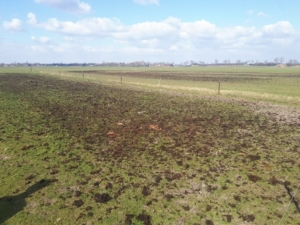Within agriculture one often speaks of dairy farmers, cattle and pig fattening farms. The horse farms are usually not named and in a sense are often a forgotten branch within the sector. However, in horses there is also manure, solid manure.
Horses are often provided with meager and fairly dry food, so both the hay and the pellets that the horse is allocated have an influence on the dry and relatively solid faeces of a horse. In addition, the faeces of a horse are collected on straw. On the one hand, this leads to organically supplied nitrogen due to a relatively high C/N ratio and, in addition, the prevailing bacterial culture will form gases. A good example of this is winter. In the winter you notice in horse stables that there is a fairly strong smell of ammonia. Apart from the fact that this is not a very pleasant smell, it can also have a negative impact on the health of humans and animals there.
When the solid manure is usually removed from the stable, it is collected on a manure heap/plate and stored. The hope then slowly starts to rot inside. The temperatures rise considerably and carbon in the heap will “burn” and thus no longer be present. In addition to the carbon, we also lose other nutrients as a result of emission gases and/or leaching. This cannot be regarded as ideal for the most efficient possible cycle and utilization of the farm’s own nutrients. Moreover, the carbon does burn, but the germination power of the unwanted (weed) herb seeds is not taken away with certainty here.
All this means that when spreading the horse manure over the fields, challenges may arise in the following areas:
The anaerobic culture does not start to mineralize during storage time, but only after spreading does this process start on the land/field. The remaining and finally released nutrients only become available to the plant at the end of the season. A “continuous” growth in which sufficient protein is present in the grass must be organized with fertilizer.
Because the nutrients are only made available at the end of the growing season, the plants are no longer able to process them and convert them into growth and fruiting. Soil life under anaerobic conditions is then also unable to fix the nutrients, so that leaching of nitrate, among other things, pollutes the water and emissions arise from the soil. Because of these losses, you have to feed the soil all over again every spring.
The carbon in the heap burns, but on the other hand, the germination capacity of the seeds in the heap is not necessarily taken away. Weed seeds of, for example, dock sorrel or creeping thistle can then sprout over the entire plot after fertilization with an incorrectly treated fertilizer. In this situation it is necessary to dig out the plants or to spray them to death, otherwise there is a chance that the other desired plants will be displaced.
A smaller but not least important aspect is the palatability of the grass. Horses often do not eat grass where their own manure has sprung up. The smell of its own manure would still be on the grass so that the horse does not want to eat it.
In addition, legal challenges could arise. On the one hand because of the pollution of the surface water by means of late released nitrogen (nitrate) or by pesticides for weed control. On the other hand because of the emission of emission gases. Depending on the location in relation to the nature reserves (Natura 2000), the regulations may be introduced more quickly and with greater impact.
So the horse farms are also increasingly confronted with challenges and changing laws and regulations. How can such companies innovate to create some security for the future?
Rinagro already has experience in composting solid manure and roadside grass, but this also includes solid horse manure. Not only with the aim of improving the manure, but the entire barn climate.
With BoxCleanair® we have already been able to achieve better air quality in several stables, as a result of the fact that we are also able to control the microbiology within this livestock sector. This reduces the emissions of not only ammonia (sharp smell), but also methane. Due to the switch of microbiology, mineralization is also starting to get going. As soon as the boxes are emptied and the manure heap takes shape, we recommend treating the heap once more for optimal composting. The benefits that BoxCleanair® can bring are:
- Mineralization in storage time, no loss of valuable nutrients through leaching or emissions.
- Germination of certain weed seeds is gone.
- The manure does not leave any ‘smell marks’ in the grass, so that the horses are used to the grass.


